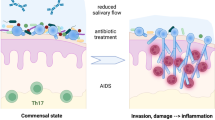Abstract
Candida albicans is an opportunistic pathogen of human mucosal surfaces. Colonization of oral and vaginal mucosa by this yeast is antagonized by the resident normal bacterial population. However, antibacterial therapy can alter the normal flora to allow fungal cells to attach, grow and invade host tissues. We studied the antimicrobic activity of fluconazole against clinical isolates of oral and vaginal bacteria and Candida albicans in vitro and in vivo by scanning and transmission electron microscopy; we also compared the bactericidal activity of fluconazole with clotrimazole in vitro by microbiologie assay. Fluconazole lysed fungi but did not change the ultrastructure of bacteria. Clotrimazole, but not fluconazole, was bactericidal against lactobacillus and streptococcus, the principal species of the oral and vaginal cavities. We conclude that Candida albicans, but not oral and vaginal bacteria, is susceptible to fluconazole. These observations help explain the antimycotic specificity of fluconazole and its efficacy against candidiasis in humans.
Similar content being viewed by others
References
Cohen MS, Black JR, Proctor RA, Sparling PF. Host defences and the vaginal mucosa. Scan J Urol Nephrol (suppl) 1984; 86: 13–22.
Larsen B, Galask RP. Vaginal microbial flora: practical and theoretical relevance. Obstet and Gynecol 1980; 55(5): 100S-113S.
Hill GB, Eschenbach DA, Holmes KK. Bacteriology of the vagina. Scand J Urol Nephrol (suppl) 1984; 86: 23–39.
Lee JC, King RD. Characterization of Candida albicans adherence to human vaginal epithelial cells in vitro. Infect Immun 1983; 41: 1024–30.
Lehre N, Sega Barr-Nea L. In vitro and in vivo adherence of Candida albicans to mucosal surfaces. Ann Microbiol (Paris) 1983; 134B: 293–306.
Troke PF, Andrews RJ, Brammer KW, Marriott MS, Richardson, K. Efficacy of UK-49,858 (Fluconazole) against Candida albicans experimental infections. Antimicrob Agents Chemother 1985; 8(6): 815–8.
Larsen B, Galask RP. Vaginal microbial flora: composition and influence of host physiology. Annals Int Med 1982; 96(2): 926–30.
Hill LVH, Embil JAE. Vaginitis: current microbiologic and clinical concepts. Can Med Assoc J 1986; 134: 321–31.
Sobel JD. Epidemiology and pathogenesis of recurrent vulvo-vaginal candidiasis. Am J Obstet Gynecol 1985; 152(7): 924–935.
Humphrey MJ, Jevons S, Tarbit MH. Pharmacokinetic evaluation of UK-49,858, a metabolically stable triazole antifungal drug in humans and animals. Antimicrob Agents Chemother 1985; 28(5); 648–53.
Saag MS, Dismukes R. Azole antifungal agents: emphasis on new triazoles. Antimicrob Agents Chemother 1988; 32(1): 1–8.
Richardson K, Brammer KW, Marriott MS, Troke PF. Activity of UK 49,858, a bis-triazole derivative, against experimental infections with Candida albicans and Trichophyton mentagrophytes. Antimicrob Agents Chemother 1985; 27: 832–835.
Lyman CA, Sugar AM, Diamond RD. Comparative activities of UK-49,858 and amphotericin B against Blastomyces dermatitidis infections in mice. Antimicrob Agents Chemother 1986; 29: 161–162.
Wilborn WH, Montes LF. Scanning electron microscopy of oral lesions in chronic mucocutaneous candidiasis. J Am Med Assoc 1980; 244: 2294–7.
Hoeprich PD, Finn PD. Obfuscation of the activity of antifungal antibiotics by culture media. J Inf Dis 1972; 126: 353–61.
Bauer TM, Kronsteiner W, Bassler M, Daschner FD. Sensitivity testing with ketoconazole in an assay containing Candida albicans, human polymorphonuclear leukocytes and serum. Eur J Clin Microbiol 1986; 5: 665–8.
Howlett JA, Squier CA. Candida albicans ultrastructure: colonization and invasion of the oral epithelium. Infect Immun 1980; 29: 252–60.
King RD, Lee JC, Morris AL. Adherence of Candida albicans and other species to mucosal epithelial cells. Infect Immun 1980; 27: 667–674.
Samaranayake LP, McFarlane TW. The adhesion of the yeast Candida albicans to epithelial cells of human origin in vitro. Arch Oral Biol 1981; 26: 815–20.
Rogers TE, JN Galgiani. Activity of fluconazole (UK 49,858) and ketoconazole against Candida albicans in vitro and in vivo. Antimicrob Agents Chemother 1986; 30: 418–422.
Odds FC. Ecology and epidemiology of Candida species. Zbl Bakt Hyg A 1984; 257: 207–12.
Sutter V. Frequency of occurrence and antimicrobial susceptibility of bacterial isolates from the intestinal and female genital tracts. Rev Inf Dis 1983; 5: S84-S89.
Eschenbach DA. Vaginal infection. Clin Obstet and Gynecol 1983; 26(1): 186–202.
Author information
Authors and Affiliations
Rights and permissions
About this article
Cite this article
Liss, R.H., Letourneau, R.J. Fungispecificity of fluconazole against Candida albicans . Mycopathologia 108, 173–178 (1989). https://doi.org/10.1007/BF00436222
Accepted:
Issue Date:
DOI: https://doi.org/10.1007/BF00436222




